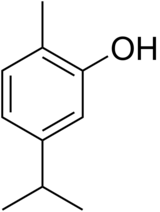Our website is made possible by displaying online advertisements to our visitors.
Please consider supporting us by disabling your ad blocker.
Carvacrol
| Carvacrol | |

| |
| Structure du carvacrol | |
| Identification | |
|---|---|
| Nom UICPA | 2-méthyl-5-(propan-2-yl)phénol |
| No CAS | |
| No ECHA | 100.007.173 |
| No CE | 207-889-6 |
| PubChem | 10364 |
| SMILES | |
| InChI | |
| Propriétés chimiques | |
| Formule | C10H14O [Isomères] |
| Masse molaire[1] | 150,217 6 ± 0,009 3 g/mol C 79,96 %, H 9,39 %, O 10,65 %, |
| Propriétés physiques | |
| T° fusion | 2,5 °C [2] |
| T° ébullition | 236,85 °C [3] |
| Masse volumique | (20 °C) 0,977 2–0,98 g·cm-3 |
| Thermochimie | |
| ΔfH0gaz | −194,2 kJ·mol-1 [3] |
| ΔfH0liquide | −270 kJ·mol-1 [3] |
| ΔvapH° | 77,74 kJ·mol-1 [3] |
| PCI | −5 650 kJ·mol-1 (liquide)[3] |
| Unités du SI et CNTP, sauf indication contraire. | |
| modifier |
|
Le carvacrol, ou cymophénol, C6H3CH3(OH)(C3H7), est un phénol monoterpénoïde. Il a un arôme chaud et piquant, caractéristique de l'origan[4].
- ↑ Masse molaire calculée d’après « Atomic weights of the elements 2007 », sur www.chem.qmul.ac.uk.
- ↑ {{Physical Constants of Organic Compounds," in CRC Handbook of Chemistry and Physics, 100th Edition (Internet Version 2019), [John R. Rumble], ed., [CRC Press/Taylor & Francis], Boca Raton, FL.}}, consulté le 15 juillet 2019
- (en) « Phenol, 2-methyl-5-(1-methylethyl)- », sur NIST/WebBook, consulté le 23 mars 2010
- ↑ (en) Ultee A, Slump RA, Steging G, Smid EJ, « Antimicrobial activity of carvacrol toward Bacillus cereus on rice », J. Food Prot., vol. 63, no 5, , p. 620–4 (PMID 10826719)
Previous Page Next Page


